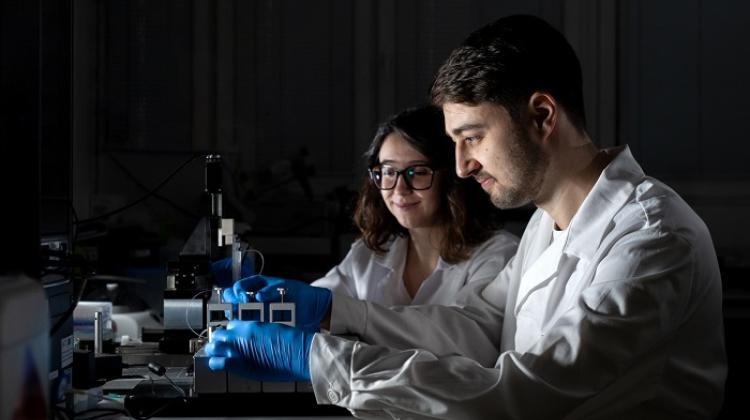Lignin can soon become more than problematic industrial waste
 A step towards photobiorefineries: photocatalysts from the Institute of Physical Chemistry PAS in Warsaw convert lignin model, which simulates paper industry waste, into useful chemical intermediates. Source: Institute of Physical Chemistry PAS, Grzegorz Krzyżewski
A step towards photobiorefineries: photocatalysts from the Institute of Physical Chemistry PAS in Warsaw convert lignin model, which simulates paper industry waste, into useful chemical intermediates. Source: Institute of Physical Chemistry PAS, Grzegorz Krzyżewski
Lignin present in wood is responsible, among others, for its cohesion and hardness. Although for the chemical industry is an interesting raw material, the difficulty of its processing results in the fact that it is only a problematic waste product in the manufacture of paper. Photocatalysts recently developed in the Institute of Physical Chemistry PAS allow to convert modelling compounds of lignin into useful chemicals.
Lignin is a sticky, almost black goo with an unpleasant smell. In nature, it occurs primarily in wood, where it is responsible for its cohesion and hardness. We can observe the spectacular results of the existence of lignin every day: thanks to it, trees do not grow horizontally; on the contrary: in spite of gravity they reach to the sky, even tens of meters tall. The content of lignin in wood is typically from 10 to 40 percent depending on the tree species. Species also have an effect on the chemical composition of lignin.
In industry, lignin is produced in large quantities in paper manufacturing, as waste in the wood softening process. World resources of lignin are huge and still growing. Estimates put it at 300 billion tons, which makes this raw material more common than crude oil, the reserves of which are estimated at approx. 230 billion tons.
"Chemically, lignin is a natural polymer with a very complex three-dimensional structure, built of many derivatives of aromatic compounds, including various phenyl alcohols. This chemical richness makes lignin a potentially very interesting raw material for the chemical industry. Unfortunately, it is also a curse, because it is very difficult to develop chemical reactions that would efficiently transform lignin into a specific, single chemical compound, readily suitable for further processing" - said Dr. Juan Carlos Colmenares from the Institute of Physical Chemistry PAS.
The difficulty of processing lignin makes it today a burdensome for the environment industrial waste with minimal importance: only 2 percent of its resources are processed and the resulting compounds have a relatively small value.
But lignin remains is a potentially important renewable source of valuable aromatic compounds for the chemical industry. The direction of research leading towards this goal is set by two new photocatalysts developed by the Institute of Physical Chemistry PAS in cooperation with the Warsaw University of Technology and the University of Cordoba. They allow to convert the lignin modelling compounds into useful chemicals, in reactions under conditions naturally occurring in nature.
"Their main ingredient is titanium dioxide TiO2, deposited on appropriately selected substrate: in one case nanocomposites containing iron oxide Fe2O3, in the second - zeolites (aluminosilicates) with a small amount of iron. Photocatalyst of nanocomposites with iron oxide was developed in close cooperation with scientists form Spain, led by Prof. Rafael Luque" - informs the Institute of Physical Chemistry PAS.
In laboratory studies at the Institute of Physical Chemistry PAS, lignin with the addition of one or the other photocatalyst was exposed to ultraviolet light, simulating the spectrum of the radiation from the sun. Both catalysts proved surprisingly effective in processing benzyl alcohol - present in the structure of lignin - into benzaldehyde. This substance is used, among others, in the production of dyes and in perfumery. In the best case, in four hours half of the original benzyl alcohol content of lignin was converted. In industrial applications, also important is the reaction selectivity: the more selective the reaction, the less its products are contaminated with unnecessary and usually difficult to separate additions. It turned out that in the solution reacted with photocatalysts the target substance represented up to 90 percent.
"In the presence of our photocatalysts, illuminated with radiation simulating sunlight, lignin reactions in the model occurred automatically at ordinary atmospheric pressure and at a temperature of approx. 30 degrees Celsius, therefore in conditions occurring naturally in sunlight. This is the exact opposite of traditional refineries, which require very complicated and expensive technical infrastructure" - noted Prof. Colmenares.
New photocatalysts have another advantage: they are cheap, because they do not require expensive precious metals, such as, for example, palladium, and the excipients are common. Moreover, one of the photocatalysts has distinct magnetic properties and after the conversion it can be easily recovered from the solution and reused.
The results obtained by scientists from Warsaw and Cordoba are promising, but they concern the reactions of photocatalysts with model compounds. Further research and tests are needed to obtain photocatalysts that can effectively process the actual lignin - heterogeneous and often with varying chemical composition.
The work on the photocatalysts involved a group of employees of the Faculty of Materials Science and Engineering of Warsaw University of Technology, led by Prof. Krzysztof Kurzydłowski.
PAP - Science and Scholarship in Poland
ekr/ mki/ mrt/
tr. RL
Przed dodaniem komentarza prosimy o zapoznanie z Regulaminem forum serwisu Nauka w Polsce.


















